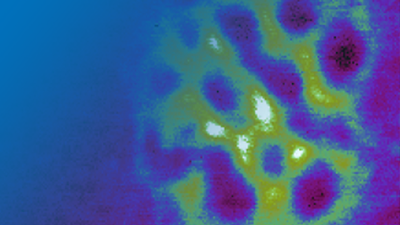Resonance Enhanced Force Volume (REFV) AFM-IR
The new Resonance Enhanced Force Volume (REFV) AFM-IR mode enables an increased range of unique nanochemical research possibilities, from multiplexed, exhaustive datasets for advanced users to beginner-friendly mechanical tracking and utility on previously challenging samples.
REFV AFM-IR combines the industry-leading sensitivity of Bruker's patented resonance-enhanced AFM-IR detection for nanochemical analysis with a force volume-based cantilever approach — easily extending sample compatibility and measurement capabilities across more applications regardless of the user's prior experience with photothermal AFM-IR technology.
Only REFV AFM-IR provides:
- Industry-standard resonance-enhanced AFM-IR measurements on fragile, soft, sticky, or otherwise difficult samples
- Simultaneous nanomechanical and nanochemical measurements
- New, easy-to-use capabilities for artifact-free imaging and spectroscopy
- Simultaneous extraction of contact resonance data to deliver large data sets with complete sample information in one scan
Effortlessly Delivering Artifact-Free, Multiplexed Datasets
REFV AFM-IR achieves:
- Same monolayer sensitivity and <10 nm spatial resolution of Resonance Enhanced AFM-IR nanochemical analysis
- Lateral force control and soft/fragile sample compatibility of Tapping AFM-IR
- Easy IR mapping without mechanical artifacts
- Extended sample compatibility with simultaneous mechanics and frequency-sweep data
“REFV AFM-IR is a powerful new tool for AFM-IR measurements, it removes the lateral forces during the scan and the frequency sweep approach provides a rich data set with the full access to mechanical properties (resonance frequency, Q factor). It is a significant development on existing AFM-IR technology and my preferred technique”
Dr. Alexandre Dazzi, Inventor of AFM-IR, University of Paris-Saclay
Resonance-Enhanced AFM-IR Measurements on Even More Challenging Samples
Perfecting resonance-enhanced detection
Like Bruker's patented Resonance Enhanced AFM-IR mode (a contact mode technique), REFV AFM-IR is based on resonance-enhanced detection—a method in which the pulse rate of the laser source is set to a resonance frequency of the AFM cantilever, delivering:
- Monolayer sensitivity
- <10 nm spatial resolution
Like Bruker's DataCube AFM modes, REFV AFM-IR performs a force-distance spectrum at every pixel with a user-defined dwell time, enabling:
- Multidimensional nanoscale information at every pixel
- Full characterization in a single experiment
Integrating sample-friendly force-volume methods
Unlike standard Resonance Enhanced AFM-IR mode, REFV AFM-IR uses a force-volume method (linear approach/retract) with an adjustable hold (dwell) time. Since the probe is not dragged on the surface, there are no lateral forces, enabling investigations of previously inaccessible samples, such as fragile nanoparticles.
REFV AFM-IR eliminates lateral forces to deliver:
- Enhanced compatibility with fragile samples
- Extended compatibility with soft, sticky, or otherwise difficult samples
Simultaneously Collect Nanomechanical and Nanochemical Data
With REFV AFM-IR, chemical and mechanical information are collected from the same pixel simultaneously. A rich dataset is gathered from a single scan, eliminating concerns about thermal drift or sample changes between separate scans:
- Nanochemical analysis is conducted using well-established photothermal AFM-IR principles.
- Nanomechanics data is extracted from the retract part of the force curve via fitting to established mechanical models
Easily Set Up and Use Mechanical Tracking / Compensation
Mapping IR absorption at fixed frequencies can lead to mechanically induced artifacts, inversion (fake) signal, or edge effects. Traditionally, it requires a skilled user and knowledge about sample mechanics to correct for these artifacts.
With REFV AFM-IR, the IR absorption is automatically mapped at the local resonance frequency using software corrections, meaning:
- True chemistry is accessible for any user and with no sample mechanics knowledge required.
- Artifact-free nanochemical imaging is available with just the click of a button.
Access Comprehensive Datasets in a Single Sweep
Conducting a frequency sweep at each measurement point simplifies experiment setup for the user and enables the collection of rich, comprehensive datasets that even go beyond simultaneous nanochemistry and nanomechanics. One complete measurement provides IR imaging, quantitative nanomechanics, contact resonance data, and Q-factor.
REFV AFM-IR uses a single scan to deliver:
- Nanochemistry from IR spectroscopy and imaging
- Nanomechanics from force curve analysis
- Dissipation and stiffness information from contact resonance analysis
